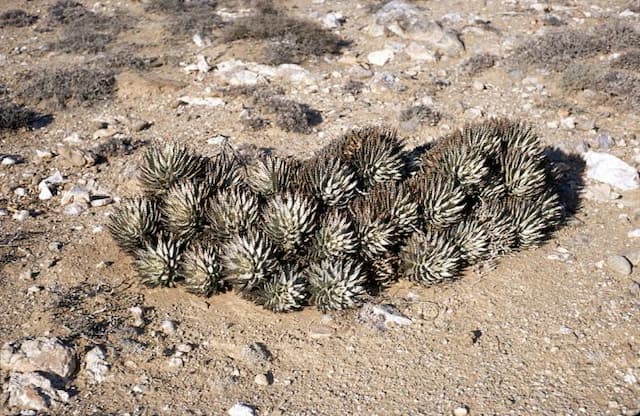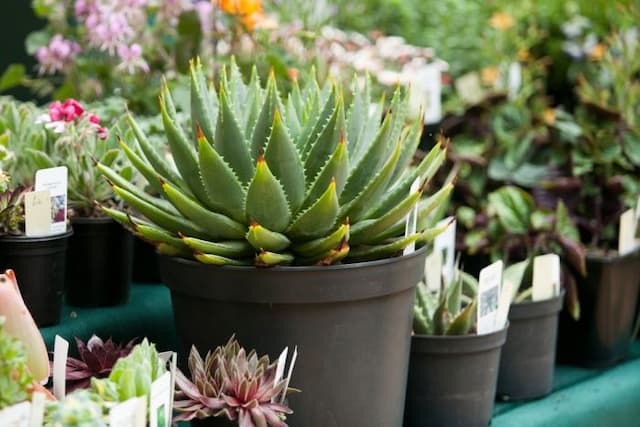Red Hot Poker Kniphofia 'Incandesce'

ABOUT
The Kniphofia 'Incandesce', commonly known as the Red Hot Poker or Torch Lily, is a striking perennial that boasts a distinctive flowering display. Its appearance is characterized by bold, upright spikes that carry a dense cluster of tubular flowers. These blossoms transition in color from the bottom up, typically starting with a warm, fiery hue such as red or orange, and then fading to a softer color like yellow or creamy white towards the tip, creating an eye-catching gradation of tones that resemble a flaming torch. The foliage of the Red Hot Poker forms an attractive, grass-like clump. The leaves are slender, arching, and almost grassy in texture, presenting in a rich green color that provides a lush backdrop for the vibrant flower spikes. Blooming mainly occurs in the summer, when the flame-like flower heads stand tall above the foliage, drawing the attention of onlookers and pollinators alike, such as hummingbirds and bees. Overall, the Red Hot Poker's most distinctive features are its brightly colored, torch-like flower spikes and its lush, grassy leaves that create a striking contrast in the garden. Its striking blossoms add a vertical element to garden beds and borders, offering a unique visual interest with their fiery display.
About this plant
 Names
NamesFamily
Asphodelaceae
Synonyms
Red Hot Poker, Torch Lily, Poker Plant
Common names
Kniphofia 'Incandesce'
 Toxicity
ToxicityTo humans
Red Hot Poker (Kniphofia 'Incandesce') is not commonly listed as a toxic plant to humans. Most species in the Kniphofia genus are not known for having toxic properties that would cause adverse effects if touched or ingested. However, it is always advisable to handle plants with care and avoid ingestion, as individual reactions can vary, and there is a potential for skin irritation or an allergic reaction in sensitive individuals.
To pets
Red Hot Poker (Kniphofia 'Incandesce') is also not commonly known to be toxic to pets. While this particular cultivar does not have a significant history of causing harm to pets, it is always best to prevent pets from ingesting plants. Non-toxic plants can sometimes cause mild stomach upset if consumed in large quantities or if the animal has a sensitive digestive system. If your pet is known to nibble on garden plants, it is prudent to discourage this behavior and supervise them to prevent any potential issues.
 Characteristics
CharacteristicsLife cycle
Perennials
Foliage type
Evergreen
Color of leaves
Green
Flower color
Mixed
Height
2-3 feet (60-90 cm)
Spread
1-2 feet (30-60 cm)
Plant type
Herb
Hardiness zones
6
Native area
South Africa
Benefits
 General Benefits
General Benefits- Attracts pollinators - Kniphofia, commonly known as Red Hot Poker, is known for attracting bees and hummingbirds, benefiting the ecosystem.
- Drought tolerance - Once established, it is quite drought-tolerant, reducing the need for frequent watering.
- Long blooming period - Provides a long season of blooms from late spring to early autumn, adding lasting color to gardens.
- Low maintenance - Requires minimal care once established, making it suitable for gardeners of all skill levels.
- Deer resistance - Typically avoided by deer, which can be beneficial in areas where deer predation on plants is a problem.
- Architectural structure - With its tall flower spikes and grass-like foliage, it provides vertical interest and contrast in landscape design.
- Variety of uses - Suitable for borders, cutting gardens, and can also be used in mass plantings to create a visual impact.
 Medical Properties
Medical PropertiesThis plant is not used for medical purposes.
 Air-purifying Qualities
Air-purifying QualitiesThis plant is not specifically known for air purifying qualities.
 Other Uses
Other Uses- Ecological indicator: The presence of Kniphofia 'Incandesce', commonly known as Red Hot Poker, can indicate a well-drained soil environment which might be useful for ecologists or gardeners looking to assess soil conditions.
- Erosion control: Due to its robust root system, Red Hot Poker can be used on slopes or areas prone to erosion to help stabilize the soil and prevent loss of topsoil.
- Photo ops: With its striking flowers, Red Hot Poker can act as an excellent backdrop or focal point for photographers, particularly in garden and nature settings.
- Nectar source for biofuel: The nectar of Red Hot Poker, like that of many flowering plants, could hypothetically be fermented to produce bioethanol, offering a less conventional source for biofuel production.
- Floral arrangements: The long-lasting and vibrant blooms of Red Hot Poker make it suitable for inclusion in fresh or dried floral arrangements, providing a touch of exoticism and height to bouquets.
- Education: Red Hot Poker can be used as a case study in educational settings to teach students about plant biology, pollination, and horticulture.
- Theme gardens: This plant is perfect for fire or heat-themed gardens due to its fiery-colored spikes, adding to the aesthetic of such themed landscaping projects.
- Habitat creation: Red Hot Poker can provide shelter and food resources for small wildlife, such as insects and birds, thus contributing to the local biodiversity.
- Art inspiration: Artists may draw inspiration from the vivid colors and unique form of Red Hot Poker for various art projects, ranging from painting to sculpture.
- Crafts: The dried flower spikes of Red Hot Poker can be used in crafts, such as for making natural wreaths or as part of ornamental displays.
Interesting Facts
 Feng Shui
Feng ShuiThe Red Hot Poker is not used in Feng Shui practice.
 Zodiac Sign Compitability
Zodiac Sign CompitabilityThe Red Hot Poker is not used in astrology practice.
 Plant Symbolism
Plant Symbolism- Red Hot Poker (Kniphofia 'Incandesce')
- Passion - The fiery red and orange colors of the Red Hot Poker blooms are reminiscent of flames, symbolizing intense passion and emotion.
- Strength and Vitality - These resilient plants can thrive in tough conditions, representing the ability to endure and maintain vitality despite challenges.
- Attraction - Just as the Red Hot Poker attracts hummingbirds and other pollinators with its bright colors, it can symbolize attraction and the power to draw in others.
- Boldness - The striking appearance of the Red Hot Poker's vibrant flowers suggests a spirit of boldness and standing out from the crowd.
 Water
WaterRed hot poker plants require consistent moisture, especially when the plants are blooming. Water these perennials thoroughly once a week, providing about one inch of water each time. It is vital to avoid overwatering, as the red hot poker does not like to sit in waterlogged soil. During hot, dry spells, you may need to water twice a week. Ensure water penetrates the soil to reach the plant's deep roots, using either a drip system or a hose directed at the base of the plant.
 Light
LightRed hot poker plants thrive in full sun conditions, where they can receive at least six hours of direct sunlight per day. They do best in a spot in the garden that is exposed to full, unfiltered sunlight to encourage vibrant blooms and maintain robust growth. Avoid planting in areas with significant shade, as too little light can inhibit flowering.
 Temperature
TemperatureRed hot poker plants are hardy in a range of temperatures and can survive minimum winter temperatures down to around 0°F. The ideal temperature range for these plants is between 50°F and 85°F for optimal growth and flowering. They can endure brief periods of higher temperatures, but prolonged heat above 90°F may stress the plants.
 Pruning
PruningRed hot poker plants benefit from being deadheaded after the flower spikes fade to encourage further blooming throughout the season. In late fall, prune the foliage down to about 3 inches above ground level to tidy up the plant and prepare it for winter. Additionally, remove any damaged or diseased foliage as needed throughout the growing season.
 Cleaning
CleaningAs needed
 Soil
SoilRed hot pokers, including Kniphofia 'Incandesce', thrive best in well-draining soil with a mixture of loam, sand, and compost. The ideal soil pH for this plant ranges from neutral to slightly acidic, about 6.0 to 7.0 pH. Amending the soil with organic matter will help ensure proper nutrition and drainage.
 Repotting
RepottingRed hot pokers, such as Kniphofia 'Incandesce', typically don't require frequent repotting as they prefer to be undisturbed. Repotting is usually done every 3 to 5 years or when the clump becomes overcrowded.
 Humidity & Misting
Humidity & MistingRed hot pokers like Kniphofia 'Incandesce' are adaptable but prefer moderate humidity levels; they can tolerate some variation but do not require high humidity.
 Suitable locations
Suitable locationsIndoor
Provide full sun and well-draining soil mix for Red hot pokers.
Outdoor
Plant in full sun, amend soil with compost, and ensure good drainage.
Hardiness zone
6-9 USDA
 Life cycle
Life cycleThe Kniphofia 'Incandesce', commonly known as Red Hot Poker, starts its life cycle when a seed germinates in moist, well-drained soil once after exposure to warm temperatures. The seedling then emerges, developing a basal clump of narrow, grass-like leaves. As the plant matures, it enters a vegetative stage, further expanding its foliage and establishing a strong root system. Upon reaching maturity, usually in the second year, it produces tall, sturdy flower spikes bearing tubular flowers that transition from yellow to orange to red, attracting pollinators such as hummingbirds and bees. After flowering, the plant may produce seeds if pollination occurs, completing the reproductive cycle. During the winter, the foliage of the Red Hot Poker may die back, especially in cooler climates, but the plant is perennial and will resume growth and continue its cycle come spring.
 Propogation
PropogationPropogation time
Spring-Early Summer
The most popular method of propagation for Kniphofia 'Incandesce', commonly known as Red Hot Poker, is by division. This is best done in the spring when new growth begins to emerge. The plant should be carefully lifted from the ground with a shovel, ensuring as much of the root system as possible is kept intact. Gardeners should then divide the clump into smaller sections, making sure each division has at least one shoot or a piece of the crown with attached roots. The divisions should be replanted at the same depth they were originally growing and spaced approximately 18 inches (45.72 centimeters) apart to allow for adequate growth and airflow. Once planted, it’s important to water the new divisions thoroughly to help establish them in their new locations.









